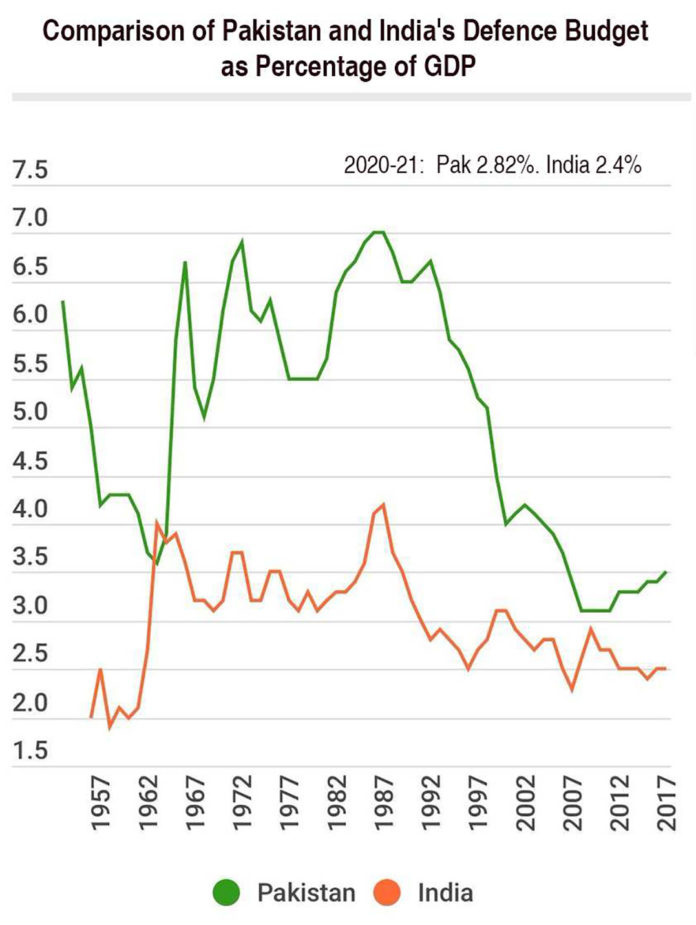The government of Pakistan announced its annual budget 2020-21, on 12 June. A sum of Rs.1, 289 billion was allotted to the defence sector. The defence budget has increased by 11.9% in the fiscal year 2020-21. When compared with 2019-20 revised spending, which was Rs.1, 227 billion, the growth would be 5%.
The amount earmarked for defence sector makes 17.68 per cent of the total expenditure planned for the 2020-21, which is estimated to be Rs 7,294.9 billion. Last year this share was 14 per cent.
When measured against the GDP, its share is 2.82 per cent. The size of the GDP is estimated to be about Rs 45,643 billion. The original allocation for the outgoing year was 2.62 per cent of the GDP.
The increasing tensions between India and Pakistan post-Pulwama and the Kashmir issue were one of the main reasons behind the increase in defence spending. The defence policy of Pakistan and military spending have always been India-centric. Pakistan attributes its large defence budget to its smaller size and the need to maintain conventional balance with India.
In the defence budget of 2020-21, the Pakistan Navy’s share increased and reached 10.85 %. Similarly, Pakistan Air Force (PAF) budget increased to 21.25%, and the army budget increased up to 47.55%. There was an increase of 20.33% in the for inter-services establishment.
In 2019-20, the navy’s share was 11.3%, while for PAF it was 22%, for army 45.4% and 21% was for the inter-services establishment. This year Pakistan navy got Rs.140 billion, PAF Rs.274 billion, army Rs.613 billion and Rs.262 billion was given to inter-services establishment.
This year the lowest increment is given to the employee related (revenue) expenses which are 5.6%. Rs.475 billion were allocated – Rs.301 billion for operating expenses which include ration, transport, POL, training and medical treatment (a 13.77% increase as compared to the previous year).
For the import of arms and ammunitions and local purchases, Rs.357 billion have been allotted, which is a 13.3% increase as compared to the previous year.
The civil works section grew by 26.14% as the amount allotted to it was Rs.155 billion. The growth in the civil work component was attributed to two major projects that were being commenced by the military i.e. the construction of border posts and fencing of Afghanistan and Iran borders.
The military had last year forgone a major hike because of the economic challenges then facing the country and settled for a raise of 4.74 per cent, but by the end of the year it had overshot the allocation by 6.33 per cent. Hence, it increased its defence budget by 11.9% in 2019-20. In comparison India had enhanced its defence spending by 6% for 2020-21.
According to the budget, Pakistan’s emphasis would be on procurement of the equipment to enhance air defence capabilities, improve operational capabilities of the naval fleet and to advance surveillance and communication systems.
Comments
Pakistan’s defence spending as a percentage of the GDP (2.82 per cent) is the highest in the region with Chinese budget as share of GDP being 1.9 per cent, India 2.4 per cent, and Iran 2.3 per cent.
Comparison of the proposed defence expenditure with the overall expenditure and as share of the GDP to a great extent resemble that of the 2018-19 budget presented by the previous PML-N government, when it was 18.5 per cent of the total pie and 2.87 per cent of the GDP.
The figures given for defence spending do not give a full picture of the amount actually being spent on defence. One major exclusion is the apportionment of pensions for the retired troops. The government would be paying Rs369 billion under this head next year – a 12.8 per cent increase over the previous year. The increase in Pakistan’s defence budget is deceptive because invariably there is an increase midway and a lot of military expenditure is hidden under different heads. These include pensions, major acquisitions and the nuclear programme.
A closer analysis of the proposed figures reveals that the biggest hike in expenses is coming under the head of civil works, which accounts for the funds marked for maintenance of existing infrastructure and construction of new buildings. The civil works component is set to grow by 26.14 per cent to reach Rs155.5 billion.
A leaked joint services headquarters memo had shown that armed forces were seeking a 20 per cent increase in salary. However, that has not happened. The employees’ related expenses would get the lowest increment of 5.6 per cent.
As compared with the budgeted Rs 1.29 trillion defence expenditure, the size of the federal developmental budget is only Rs 650 billion. This shows the priorities of the government and the dominance of the military. Pakistan’s own latest Economic Survey has revealed that the country is bracing towards a massive and widespread joblessness due to the lockdowns and restrictions, required to curb the spread of the deadly coronavirus.
Pakistan Economic Survey 2019-20 has estimated a staggering number of 1.4 million to 18.53 million people going jobless in the country. The survey maintains that the ongoing restrictions and lockdowns due to coronavirus may see at least 2.2 per cent of the country”s employed workforce going jobless, while in case of a lockdown under limited restrictions, the numbers of joblessness in the country would hover around 1.4 million.
In monetary terms, the overall job loss would interpret into at least Rs 23.6 billion. A complete lockdown would interpret to push at least 18.53 million people, which is about 30 per cent of the labour force to unemployment, which job losses worth at least Rs 315 billion.


















